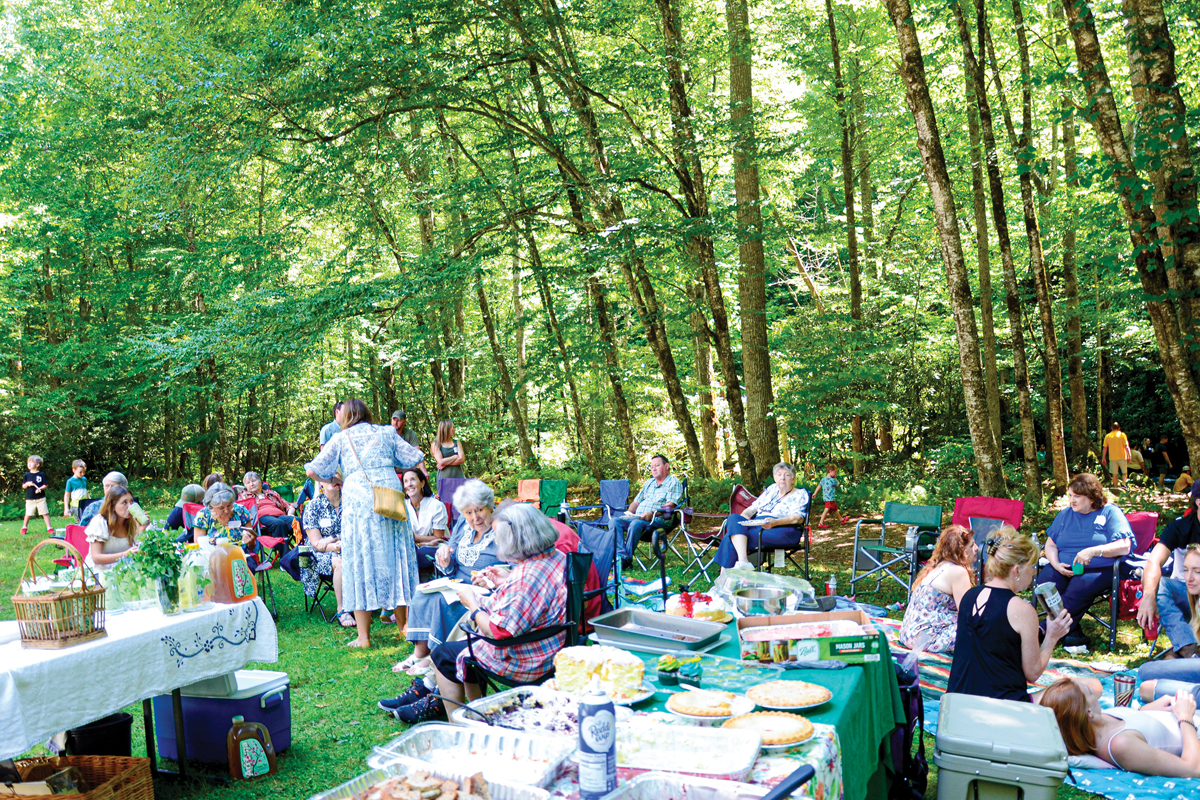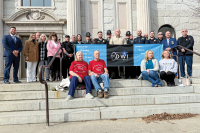Word from the Smokies: Reunion brings Cataloochee descendants home to the valley
 The tables are still full of food as reunion attendees spread out on the lawn to eat and enjoy each other’s company. Holly Kays photo
The tables are still full of food as reunion attendees spread out on the lawn to eat and enjoy each other’s company. Holly Kays photo
Shadows and seasons are the main markers of time in Cataloochee Valley, a remote corner of Great Smoky Mountains National Park located more than 20 miles from the closest town and reachable only by a windy, narrow gravel road.
But today, the belltower at the historic Palmer Chapel Methodist Church aids the valley’s natural timekeepers with a resounding ring, calling worshippers to 11 o’clock service. It’s the second Sunday in August, a date that, since 1937, has marked the annual reunion of families who trace their ancestry back to Cataloochee. The air is alive with glad greetings between long-missed friends and family, the sounds of children playing along the nearby creek, and enticing aromas curling through the corners of covered dishes filling long tables on the lawn.
“There’s a real connection to the valley, with all the families,” said Steve Woody, who has organized the reunion every year since 1975. “And now you’re talking about children, grandchildren, great-grandchildren — but they still come back.”
While the Cherokee people had long hunted and fished Cataloochee Valley, archeological evidence suggests that the first permanent settlement was established in the 1840s by the reunion-goers’ ancestors. They had cleared the land, developed fields, built homes and relied on the distant outside world as little as possible — though some families entertained paying customers who came to Cataloochee to fish, ride horses or hike. By 1910, Cataloochee Valley and the even more isolated Little Cataloochee were home to a combined 1,251 people.
When the park was created, they were forced to sell. By 1938, all but a few families had left the valley.

Related Items
Cars fill the lawn at Palmer Chapel Methodist Church during the 1947 reunion of families in Cataloochee Valley. Steve Woody photo
The community held a picnic at the Woody house as the exodus unfolded, and there they decided that such a reunion should become an annual tradition. Woody’s father Jonathan Woody was elected president and gave the opening address at the inaugural reunion in 1937 — stressing, as reported by The Waynesville Mountaineer, “the fact that this reunion should be held every year in honor of those that have passed on, the older ones who take such pride in the occasion, and that the younger people might know the feeling of friendship that has always existed in this locality among kinsman [sic] and neighbors.”
Against all odds, the tradition persisted. That first reunion drew between 600 and 700 people from nine states, the paper reported, and by 1995 attendance was still at 550. In the decades since, the generations that were born in Cataloochee have largely passed away, but the place still exerts a powerful pull on the hearts of their descendants. This year, 328 people attended the reunion, some coming from as far away as California or Texas.
“It’s like going home,” Woody said.
Everyone has a favorite story, myth or memory to share about life in the valley. For John Palmer, it’s the tale of his great-grandfather William Palmer and the “big, expensive horse” named Big Mac he bought during his 1910 campaign for Haywood County sheriff. His opponent had more money, but riding Big Mac, William Palmer could “beat him up every cove, where he could go kiss all the babies,” securing his win.

Attendees of the 1947 reunion of families in Cataloochee Valley load their plates during a communal meal on the lawn. Steve Woody photo
Woody’s favorite story sits on the other side of the law. In 1900, Cataloochee needed a new school, so Woody’s grandfather, also named Steve Woody, traveled to Waynesville with a couple of cousins to ask for funding. When the county commission turned them down, the men decided to take matters into their own hands. Under cover of darkness, they dragged the school’s furniture and supplies into a field, put a match to the empty building, and never told anybody what they’d done until decades after the resulting new school was built.
Other stories reside in more recent memory. For Ronnie Trantham, whose grandfather Mark Hannah was born in Cataloochee and later worked as a park ranger there, the second Sunday in August takes him back to his childhood, when he spent summers bookended by Decoration Day and the August reunion hiking, biking and fishing the valley. Joy Messer Townsend, who now lives in Mississippi, remembers summers and Christmases in the old Caldwell house, which her grandparents rented from the park through the mid-1960s. Townsend, who was about 10 years old when they moved out, recalls the backyard garden, the delicious smell of a freshly opened ham from the smokehouse and lamplight illuminating the house on Christmas morning. Each year, the reunion brings it all back.
“It reminds me of when I was a young child and would come and spend the night in the Caldwell house, listening to the creek,” she said. “It would keep me awake some nights, and then some nights it would just lull me to sleep.”’
As the church bell rings, worshippers ranging from aged to infant ascend the old stone staircase and fill the wooden pews before spilling out the doorway or scattering about the lawn. Woody rises to the pulpit to offer an invocation.
“Father, as we gather again as family and friends in our beloved Cataloochee Valley, we thank you for this day and the abundance of this land,” he prays. “We thank you for our forefathers who, often through great struggle, have given us a heritage of courage, wisdom, hope, and love.”

Harley Caldwell rises to be recognized as the only person born in Cataloochee Valley in attendance that day. Holly Kays photo
Canton native Richard Hurley performs his song “Cataloochee,” inspired by his first reunion experience in 2018, and then leads the congregation in a collection of songs printed in the old paperback hymnbooks — “Leaning on the Everlasting Arms,” “There’s Power in the Blood,” and “Shall we Gather at the River.” Woody recognizes those with the closest familial connection to the valley, then asks attendees to stand for the clan they represent. Before taking up an offering and turning the pulpit over to Rev. Keith Turman of First United Methodist Church in Waynesville, he invites Friends of the Smokies President and CEO Dana Soehn and Smokies Acting Deputy Superintendent and Chief Ranger Boone Vandzura to speak.
“Family is important,” Vandzura says, “so it’s wonderful for all the folks that are gathering together and remember the folks that can’t be here with us, or the new ones that were born since the last reunion. It’s so special to have everyone together. I’m glad to be able to enjoy this with you all.”
Vandzura isn’t the only attendee in green and gray. Outside, park rangers help direct traffic and answer questions. When the service ends, they’re invited to enjoy plates of fried chicken, creamy casseroles, summer salads and myriad desserts along with everyone else — a testament to how much healing has taken place since the wounds of the 1930s.
To the untrained eye, Cataloochee may seem a timeless place, where the present can’t outrun the past. But the hundreds who gather on its lawn each August know that’s not true. This year, only one person — Harley Caldwell — rose when Woody called to recognize those who had been born in the valley. And in a startling announcement, Trantham, who has led hymns at the service for close to 20 years, told the group that Hurley would be taking over song-leading going forward. “I felt like it was time for someone else to do it,” he said.

Palmer Chapel was built in 1898 on land deeded by Mary Ann Palmer. It had no resident minister and relied on circuit riders, who typically came on the third Sunday of each month. The local congregation coordinated Sunday School on the remaining Sundays. Holly Kays photo
Time marches on. But Cataloochee’s descendants refuse to forget. On the second Sunday in August, they come together to worship, to eat and to remember where they are from.
“And that not only gives us the inspiration,” said Turman, “but it gives us the courage to go forward.”
(Holly Kays is the lead writer for the 29,000-member Smokies Life, a nonprofit dedicated to supporting the scientific, historical, and interpretive activities of Great Smoky Mountains National Park by providing educational products and services such as this column. Learn more at SmokiesLife.org or reach the author at This email address is being protected from spambots. You need JavaScript enabled to view it..)













